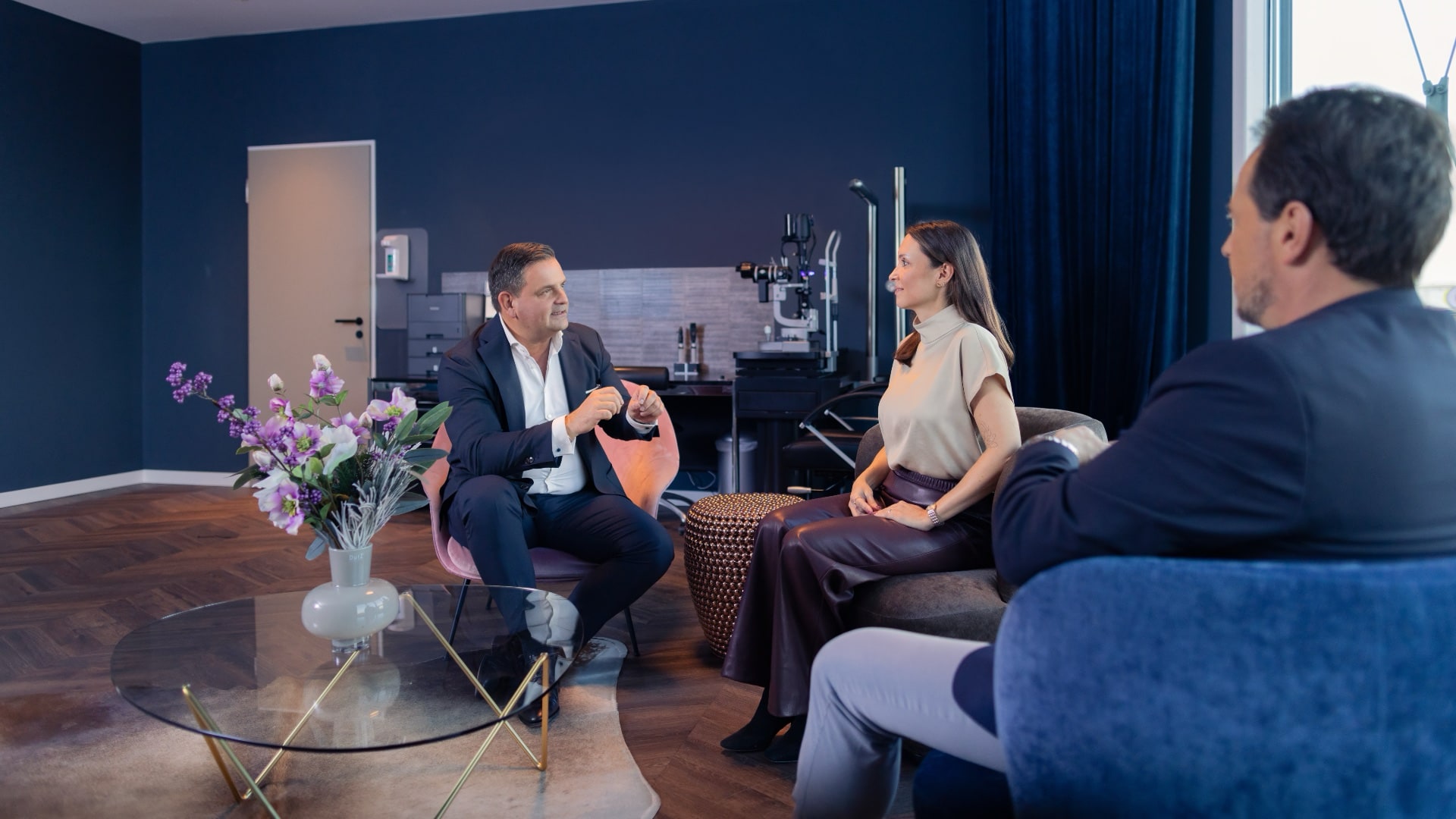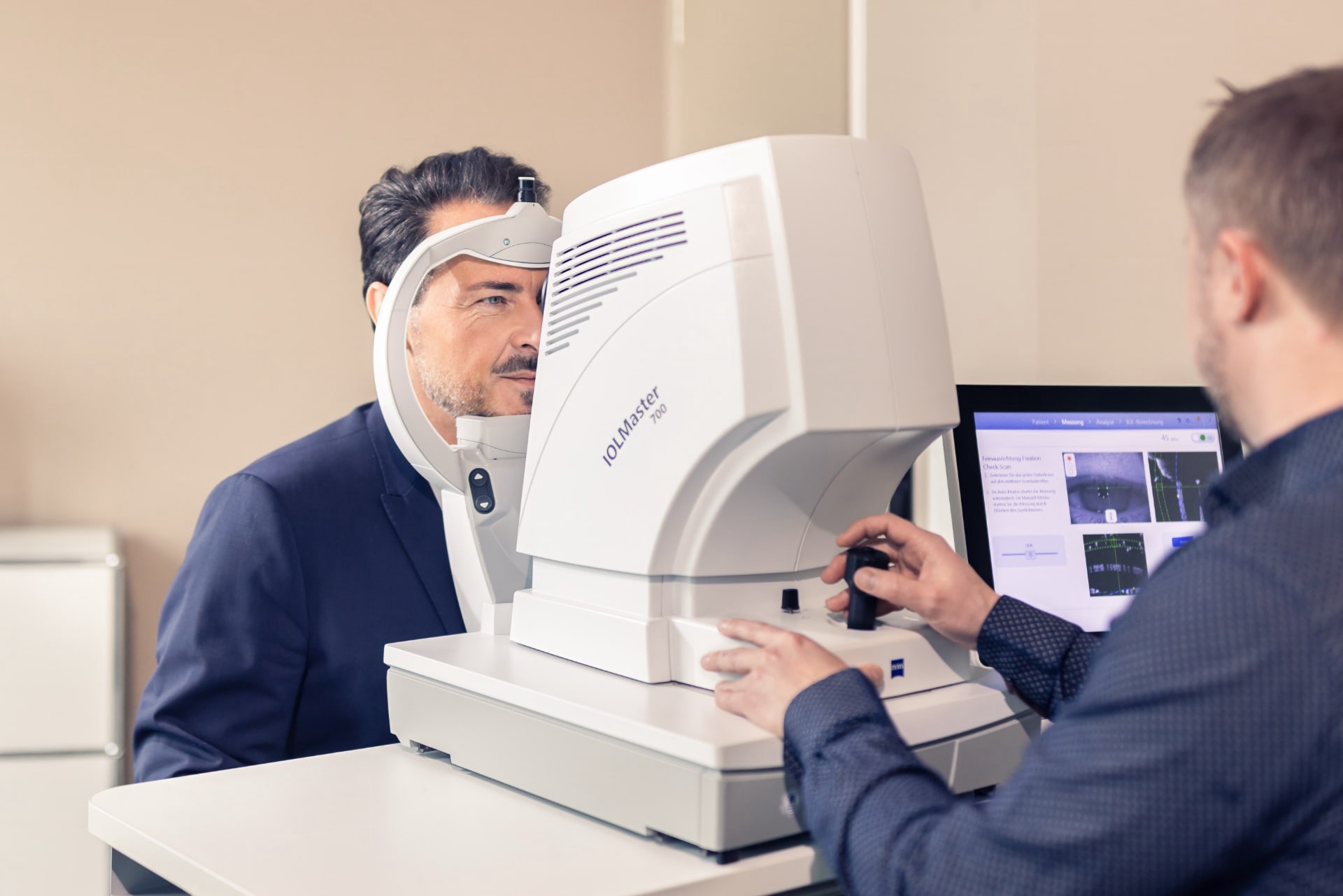Comparison of morphologic features of clear corneal incisions created with a femtosecond laser or a keratome — PDF, 5.14 MB >
Grewal D. S., Basti S., in: Journal of Cataract Refraktive Surgery April 2014; 40:521-530; Ausg. zur ASCRS und ESCRS

Experience has shown us: The more precise the preliminary examination is, the better the surgical result. We do not only use preliminary examinations to determine whether you are suited for a refractive surgery but also to precisely plan the cataract operation.

The reason is that the result of the operation is influenced to a large part by thorough diagnostics of the eye. These include measuring the anterior and posterior part of the eye with state-of-the-art technology and examining the eye for disease to take no risks. By the way, some operations can also be combined with cataract surgery, such as e.g. surgical treatment of glaucoma.
Important information for contact lens wearers: Please do not wear contact lenses for a period of two weeks before the preliminary examination.
On the day of the cataract operation, you will receive disinfecting eye drops; hair and body are covered, and the skin around the eye to be operated is disinfected; then, an eye speculum is placed to ensure that the eye remains open.
Using a surgical microscope, your surgeon makes a tiny incision at the outer edge of the eye to gain access to the natural lens.

The lens is suspended in the lens capsule which is opened with a circular incision (capsulotomy). To remove the eye's natural lens, it is broken up with ultrasound energy, enabling it to be suctioned without problems by means of tiny instruments. This procedure is called phacoemulsification.
Finally, the transparent artificial lens is placed in the empty lens capsule. For this, tiny instruments in which the folded lens is placed are also used. In the capsular sac, the lens unfolds and finds purchase. Depending on the type of lens, the surgeon aligns the lens precisely to provide optimum quality of vision.
Outpatient cataract surgery takes 20 minutes at most. If additional risks are present, we would perform the cataract surgery on an inpatient basis. You can find additional specialist literature references on this topic on this page below.

Choosing your surgeon is a material factor for your surgical result. Dr. Breyer is considered a pioneer and specialist for cataract and refractive surgery internationally and has been included in the Top-Mediziner list of doctors curated by the magazine Focus since 2013. He has contributed to developing the minimally invasive surgical technique for cataract surgery and has been using a femtosecond laser at the patient's option for cataract surgery since 2012. Furthermore, the selection of premium lenses is also one of his fields of expertise. In 2015, he developed blended vision according to the Düsseldorf formula and was awarded a prize in the "innovation" category of the Congress of European Eye Surgeons for it.
Prof. Dr. Kaymak is our leading surgeon for retina, macula and vitreous body surgery and head of our Macula Retina Myopia Center. His areas of expertise also include cataract surgery and the treatment of diabetes-related eye diseases. To make an appointment for a cataract operation, simply call our hotline. We also offer same-day appointments.
Since May 2012, we have been performing cataract surgery with a femtosecond laser at the patient's option. Please read more about this in the chapter on laser lens replacement. We are particularly proud to be able to offer you the latest generation, the LENSAR ALLY, from August 2024 – as the first in Europe! The use of the femtosecond laser provides you with an additional feeling of security and enables an even more precise alignment of the artificial lens in the eye. This is of particular importance if you choose a premium lens. We will be happy to advise you on the type of lens best suitable for you. Do you want to know more about artificial lenses implanted in cataract surgery? Then please continue reading in the chapter on multifocal lenses. In it, you can also find all information about our concept for individual lens selection, 'MI-LENS'.
Grewal D. S., Basti S., in: Journal of Cataract Refraktive Surgery April 2014; 40:521-530; Ausg. zur ASCRS und ESCRS
Reddy K. S., Kandulla J, Auffarth G, Journal of Cataract Refraktive Surgery 2013; 39:1297-1306, Ausg. zur ASCRS und ESCRS
Knorz M.C., Lerche R-C, Breyer D., Kohnen T., Ophthalmo-Chirurgie 25, (Suppl. 3), 1-6, Juli 2013
Breyer D., Ophthalmo-Chirurgie, 25, April 2013, 71-74
Straub L, Cataract and Refraktive Surgery Today, Europe 4/2010: 43-53
Daily S, Cataract and Refraktive Surgery Today, Europe 3/2011: 92-94
Neil J. Friedman, MD, Daniel V. Palanker, PhD, Georg Schuele, PhD, Dan Andersen, MS, George Marcellino, PhD, Barry S. Seibel, MD, Juan Batlle, MD, Rafael Feliz, MD, Jonathan H. Talamo, MD, Mark S. Blumenkranz, MD, William W. Culbertson, MD, Cataract and Refraktive Surgery Today, Europe 2011, Vol. 37:1189–1198 Q 2011 ASCRS and ESCRS
EyeWorld, 2011 ASCRS; ASOA San Diego Show Daily Supplement, 1-3
LenSx Laser System, Knorz M. C., Cummings A. B., Cataract and Refraktive Surgery Today Europe, December 2012: 50
Miháltz K, Knorz C, Alió J L, Takács A, Kránitz K, Kovács I, Nagy Z Z, Journal of Refraktive Surgery, Vol. 27, No. 10, 2011, 711-716
Kránitz K, Knorz M C, Takács A, Kránitz K, Kovács I, Miháltz K, Nagy Z Z, Journal of Refraktive Surgery, Vol. 27, No. 8, 2011, 558-563
D. V. Palanker, M. S. Blumenkranz, D. Andersen, M. Wiltberger, G. Marcellino, P. Gooding, D. Angeley, G. Schuele, B. Woodley, M. Simoneau, N. J. Friedman, B. Seibel, J. Batlle, R. Feliz, J. Talamo, W. Culbertson, Sci. Transl. Med. 2, 2010
Ecsedy M, Miháltz K, Kovács I, Takács A, Filkorn T, Nagy Z Z, Journal of Refractive Surgery, Vol.27, No. 10, 2011, 717-722